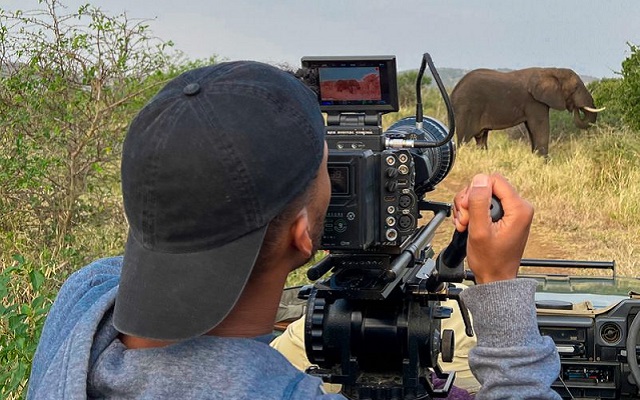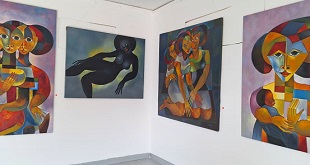
Kampala, Uganda | THE INDEPENDENT | In 2017, two South African National Geographic Explorers and filmmakers, Noel Kok and Pragna Parsotam-Kok created the Nature, Environment and Wildlife Filmmakers (NEWF), which empowers Africa’s next generation of storytellers to promote conservation through film.
“We are building an army of young, inspired producers, directors, cinematographers, composers, and writers all across Africa, focusing on storytelling in environment and wildlife. The reason we are doing this to meet the opportunities that exist within the industry for our fellows to become part of the crews, so the stories of Africa are told from the perspective of Africans,” said Noel Kok.
To amplify their impact, NEWF collaborated with the National Geographic Society in 2022 to develop Africa Refocused, a five-year program dedicated to continuing NEWF’s capacity-building initiatives for emerging African storytellers to own and drive the narrative about the need to protect the continent’s natural habitats and wildlife.
Bird story agency sat down with Rachael Stretcher, National Geographic’s Vice President, Storytelling at the annual NEWF Congress, which took place between February 24-27 in Durban, South Africa, to find out how Africans are increasingly telling African nature and wildlife stories. She discusses ways the organisation – known across Africa as Nat Geo – is encouraging representation by African filmmakers, local distribution, the mechanics behind grant decisions, and what makes a great Nat Geo proposal.
The Western world has long told African wildlife and conservation stories. How is National Geographic working to ensure that these stories from Africa are Africa-led and based on Africa’s needs?
It starts at many levels. And one of them is ensuring African role models are in this space. And they can look like Paula Kahumbu, the Kenyan wildlife conservationist.
I want to ensure that a young girl in rural Kenya will grow up and see somebody who looks like her. She will see a scientist, or a conservationist or a filmmaker, and see that they look like her, come from a place that she recognises, and she can see herself becoming that person. That’s the most basic level,
Africa Refocused, our collaboration with NEWF, invests in storytelling on the continent in a way that allows us to find new talent and support people across Africa. And we’re pleased to partner with this organisation in this way.
But it’s also about creating content and understanding where to distribute it so that young Africans have access to that work which inspires wonder in the natural world and it’s work that they relate to.
It’s also about ensuring people have access to tools; while conservation is expensive, storytelling is extremely expensive and something that historically only the very privileged had access to. Many are photographers of people, but photographers of wildlife and natural history are on another level. Access to a basic kit is tens of thousands of dollars, and that’s just entry-level.
And so we start by supporting programmes like NEWF that give people from Africa basic education and access to the necessary tools. But once they’re ready to matriculate into our grant programme, we don’t just say here’s $20,000; bye and good luck. That is not the best way to ensure success in a system that is highly confusing and very difficult to navigate.
Once somebody receives a storytelling grant, we have a series of programmes around mentorship that they can participate in. One is called the Second Assistant program, which pairs early-career photographers from diverse backgrounds with some of our most experienced photographers as they head out into the field on assignment. We pay the mentees while they get critical hands-on experience.
The second programme is the Field Ready Program, a partnership with Disney, which trains entry-level participants to become production assistants. Here, we have a series of master classes, and they include some of the most globally recognised directors. But then, each fellow who’s part of that mentorship programme is again embedded on a shoot where they get hands-on experience.
These are just a series of programmes we’ve developed to ensure that we have representation in Africa and among women, mainly because this is an area where this lack of representation exists. And we’re not there yet, but we are always trying and keep developing these programmes.
For African storytellers who want to pitch to Nat Geo, what are the key things you look for in an application that they should include to increase their selection chances?
The first thing is how well you answer the question; why are you the best person to tell this story? And that may be several things. One is because you have a very specific and close connection to the community you’re covering or because your portfolio represents an enormous amount of talent and experience that shows you can do the project well.
We are looking for seasoned storytellers. Even for level-one projects, we want people with several years under their belt, and people who are currently in college are usually not quite ready.
The second thing we look for is that the project is compelling. We want to see something that’s well-researched and exciting. I read hundreds of applications, and that’s after the programme officers have read them and pared them down for me. And so when I go through those, I want to read something new, exciting and compelling. And that feels urgent and critical.
Third, it needs to align with our focus areas as National Geographic; these include human history and culture, human ingenuity, wildlife, land and oceans.
On focus areas, what critical elements in a story will make the pitch stand out for you?
We want to see stories that are grounded in people’s own communities. And usually, those stories are different from the ones we’ve been told and seen over and over again.
But the other thing that’s critical in guiding us is that, because I am based in Washington, DC, I won’t know what’s relevant here. We, therefore, have a global set of external reviewers from all over the world who sit with us in a panel discussing each of those projects. Noel Kok, the founder of NEWF, is among our reviewers.
And the questions that come up are usually: Is this a story that we’ve all heard before? Too many times? Are they telling it with a sense of nuance? Are they grounded in this community? How will they express this in a way that is not extractive of this community? How well an applicant communicates this in the proposal influences our discussions and decisions.
How does Nat Geo ensure local distribution of films to increase visibility so that beyond international screenings, locals also have access to films shot in the communities?
The way it works is that National Geographic Magazine has the first right to publish the work that we’ve funded; not always, but almost all the time.
And that’s often a big deal and a great opportunity for a young storyteller because it means a lot to get published in National Geographic. However, in the application, one thing I should have mentioned is that we always want to know what your plan for distribution is. And the answer should not be YouTube or making a website yourself.
At National Geographic, we have found that local conversations are much more valuable than global ones. I mean, it’s wonderful to have work published internationally in The Times, CNN and all, as it means a lot for people’s careers. But when it comes to impact and changing policy, it’s much more common that businesses will stop polluting the ocean in the community when the work is published in that community newspaper or television show. Policies shift at community levels, so it’s important that work is published locally too.
As I said, we are not working with early-career people but pretty seasoned journalists. It’s extremely rare that they become funded by us and don’t find a local broadcast home because it’s work that was blessed by this international organisation. It’s also very good because we’ve edited it carefully.
How do you measure the impact of the films you’ve funded?
It’s really hard. And it’s often about keeping up not just one year later but three, five years, ten years later because this is often a long game. Sometimes policy change can happen fast, but not always.
We funded one photography project in 2017 by Steven Winter, looking at illegal backyard zoos in the United States. Last December, the United States passed a law banning backyard zoos nationally. But that took about six years.
In what ways do you think storytelling has changed over the years, even with Nat Geo?
Often when we talk about the value and impact of storytelling, we always think that we have to tell stories of sadness and tragedy. And yet, there is a lot of research now that behaviour change and an opening up of people’s minds are sparked through work that sparks curiosity, awe, and wonder.
And that’s exactly the sweet spot of the work of National Geographic, which is what it does. And it takes people to a place where they’re willing to ask questions. The core of everything we do – education, storytelling, and science – is about asking a question rather than claiming that you know and telling people what to do. That’s how you tell a good story.
*****
Source: bird story agency
 The Independent Uganda: You get the Truth we Pay the Price
The Independent Uganda: You get the Truth we Pay the Price

